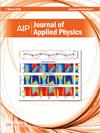Transparent and flexible zinc oxide-based thin-film diodes and thin-film transistors: A review
IF 2.5
3区 物理与天体物理
Q2 PHYSICS, APPLIED
引用次数: 0
Abstract
Electronics today has evolved significantly, including its application in transparent and flexible devices. Flexible electronics offers new product concepts, including low production cost, low energy consumption, and sustainable and environmentally friendly materials. This concept leads to the development of novel materials that realize today’s requirements. Incorporating optically transparent and flexible thin-film-based devices into the electronic circuitry helps in maintaining high conductivity along with achieving the similar electronic behavior of the conventional electronic gadgets. Thin-film diodes (TFDs) and thin-film transistors (TFTs) are the core materials to be incorporated as building blocks for flexible devices. Among them, oxide-based thin films have been marked to be significant because of their efficient electrical performance, low temperature processing, and device flexibility. The present article reviews the concepts and application of zinc oxide (ZnO) as the semiconducting material for flexible thin-film devices. We also review flexible and transparent TFDs and TFTs that are based prominently on ZnO as the semiconducting material. Furthermore, the present issues have also been addressed.透明柔性氧化锌基薄膜二极管和薄膜晶体管的研究进展
今天的电子产品已经有了显著的发展,包括它在透明和柔性设备中的应用。柔性电子产品提供了新的产品概念,包括低生产成本,低能耗,可持续和环保材料。这一概念导致了新材料的发展,以满足当今的需求。将光学透明和柔性薄膜器件集成到电子电路中有助于保持高导电性,同时实现与传统电子器件相似的电子行为。薄膜二极管(TFDs)和薄膜晶体管(TFTs)是柔性器件的核心材料。其中,氧化物基薄膜因其高效的电性能、低温加工和器件灵活性而被标记为具有重要意义。本文综述了氧化锌作为柔性薄膜器件半导体材料的概念及其应用。我们还回顾了基于ZnO作为半导体材料的柔性和透明tfd和tft。此外,目前的问题也得到了解决。
本文章由计算机程序翻译,如有差异,请以英文原文为准。
求助全文
约1分钟内获得全文
求助全文
来源期刊

Journal of Applied Physics
物理-物理:应用
CiteScore
5.40
自引率
9.40%
发文量
1534
审稿时长
2.3 months
期刊介绍:
The Journal of Applied Physics (JAP) is an influential international journal publishing significant new experimental and theoretical results of applied physics research.
Topics covered in JAP are diverse and reflect the most current applied physics research, including:
Dielectrics, ferroelectrics, and multiferroics-
Electrical discharges, plasmas, and plasma-surface interactions-
Emerging, interdisciplinary, and other fields of applied physics-
Magnetism, spintronics, and superconductivity-
Organic-Inorganic systems, including organic electronics-
Photonics, plasmonics, photovoltaics, lasers, optical materials, and phenomena-
Physics of devices and sensors-
Physics of materials, including electrical, thermal, mechanical and other properties-
Physics of matter under extreme conditions-
Physics of nanoscale and low-dimensional systems, including atomic and quantum phenomena-
Physics of semiconductors-
Soft matter, fluids, and biophysics-
Thin films, interfaces, and surfaces
 求助内容:
求助内容: 应助结果提醒方式:
应助结果提醒方式:


